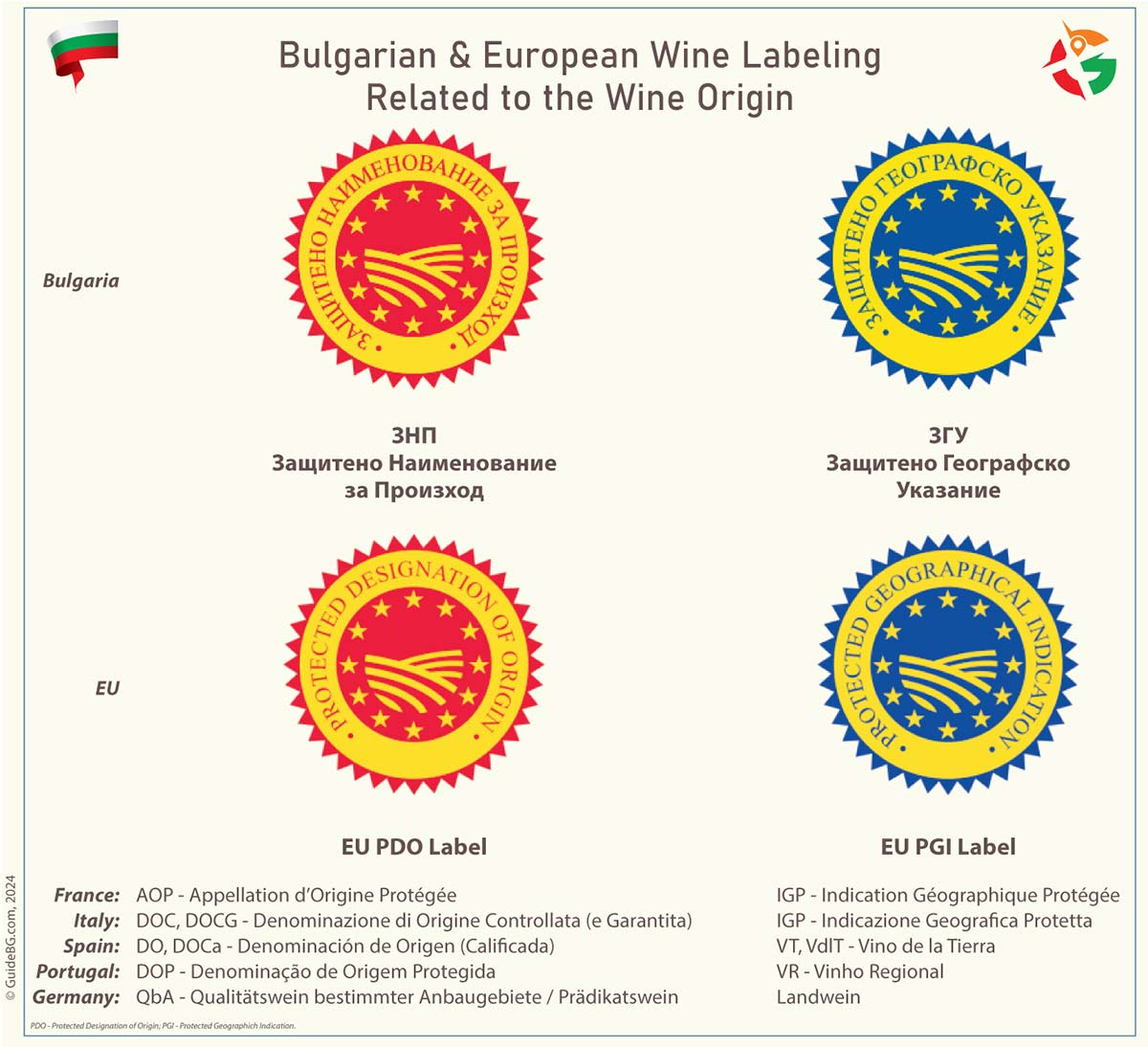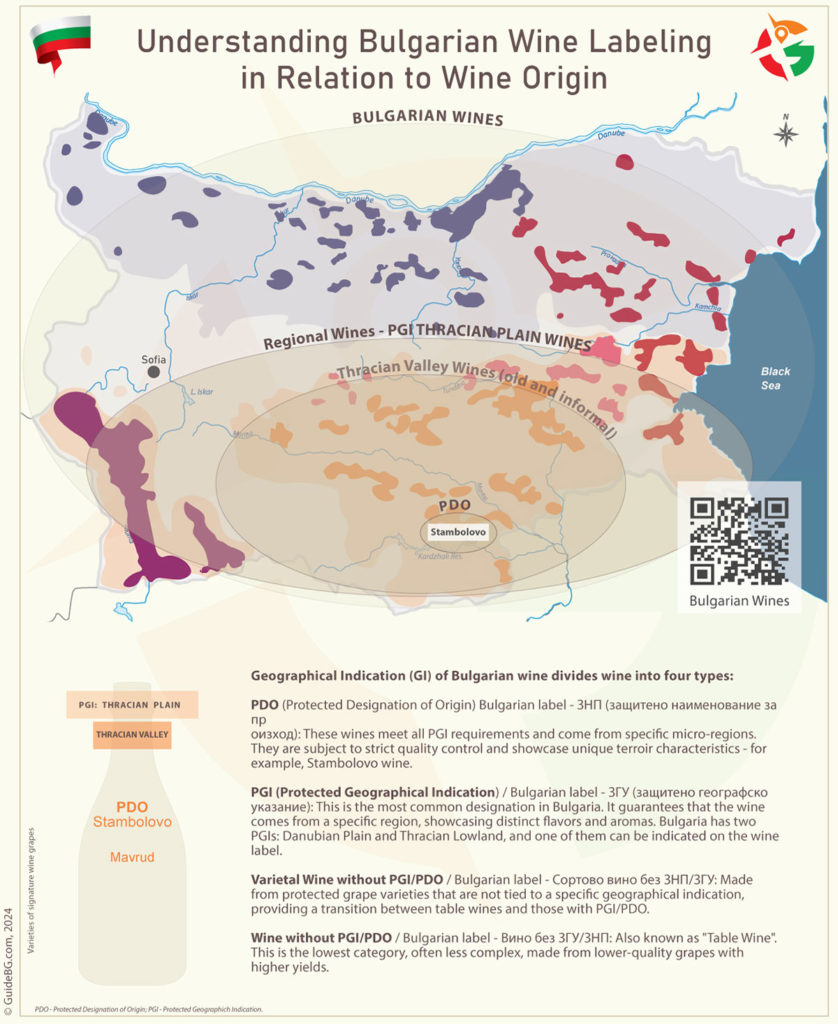1978 Bulgaria adopted its first official Wine Law, regulating quality categories. This document, similar to French legislation, emphasized the importance of origin and production area. After 2000, Bulgaria updated this law, harmonizing it with European standards. Today, Bulgarian wines fall into two main categories: table and quality wines from specific regions. Here, we will look closer at labeling wines from specific regions (PGI) and PDO.
The Excellence of European Agricultural Food Production
European agricultural food production stands out for its exceptional quality, embodied in products bearing the PDO (Protected Designation of Origin) and PGI (Protected Geographical Indication) labels. These designations represent the culmination of unique human and environmental factors specific to certain territories.
The European Union enforces stringent regulations to safeguard these products, ensuring consumers’ trust and providing producers with tools to identify better, promote, and protect their goods from unfair practices. Geographical indications like PGI and PDO highlight Europe’s cultural diversity and rich agricultural heritage. They preserve specific knowledge, authenticity, and agro-environmental conditions.

Understanding AOP and IGP Wines: What Do They Mean?
Mandatory Wine Label Information Related to the Origin
Bulgarian wine labels must include certain mandatory information about the wine’s origin. This ensures consumers know precisely what they are purchasing.

Geographical Indication (GI) Labeling
- PDO (Protected Designation of Origin) Bulgarian label – ЗНП (защитено наименование за произход): These wines meet all PGI requirements and come from specific micro-regions. This standard requires all grapes to come exclusively from the geographical area where the wine is made. They are subject to strict quality control and showcase unique terroir characteristics – for example, Stambolovo wine. There are 52 PDO designations in Bulgaria as of 2024.
- PGI (Protected Geographical Indication) / Bulgarian label – ЗГУ (защитено географско указание): This is the most common designation in Bulgaria. It guarantees that the wine comes from a specific region, showcasing distinct flavors and aromas. This standard requires that at least 85% of the grapes used come exclusively from the geographical area where the wine is made. Bulgaria has two PGIs: Danubian Plain and Thracian Lowland, and one of them can be indicated on the wine label.
- Varietal Wine without PGI/PDO / Bulgarian label – Сортово вино без ЗНП/ЗГУ: Made from protected grape varieties that are not tied to a specific geographical indication, providing a transition between table wines and those with PGI/PDO.
- Wine without PGI/PDO / Bulgarian label – Вино без ЗГУ/ЗНП: Also known as “Table Wine“. This is the lowest category, often less complex, made from lower-quality grapes with higher yields.
| PGI Danubian Plain: | PGI Thracian Plain: |
| Euxinograd, Khan Krum, Lovech, Lom, Lozitsa, Lyaskovets, Montana, Northern Black Sea Coast, Novi Pazar, Novo Selo, Oryahovitsa, Pavlikeni, Pleven, Ruse, Shumen, Silven, Suhindol, Svishtov, Targovishte, Varbitsa, Veliki Preslav, Vidin, and Vratsa | Asenovgrad, Bolyarovo, Brestnik, Dragoevo, Harsovo, Haskovo, Hissarya, Ivaylovgrad, Karlovo, Karnobat, Lyubimets, Melnik, Nova Zagora, Pazardzhik, Perushtitsa, Plovdiv, Sakar, Sandanski, Septemvri, Shivachevo, Slavyantsi, Southern Black Sea, Stambolovo, Stara Zagora, Struma Valley, Sungurlare, Thracian Valley, Varna, and Yambol |
- Origin: The country where the wine is produced. In this case – Bulgaria.
For more detailed information about Bulgarian wine regions and designations, click here.
Additionally, information about the alcohol content, sugar content indication, sulfite content, batch number, and producer/importer must be included.
Additional Label Information Related to the Origin
Optional information enhances the wine’s appeal but is not legally required. Some producers may include unofficial details about older wine regions, such as the Struma Valley or Rose Valley.
The label can also feature traditional designations like the Guaranteed Appellation of Origin (GPA) and the Guaranteed and Controlled Appellation of Origin (GCA).
Bulgarian wine labels must provide information to help consumers make informed choices about the wine’s origin. However, this is not always the case. Even today, you may find wines on the market that are incorrectly labeled or labeled in a way that misleads the consumer. Be aware of this fact, and ask the store to clarify.
For complete information on Bulgarian wine labeling, click here.


